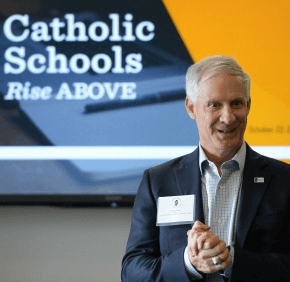
Lisa Shipley, right, shares a comment with Emily Mehler during an operational efficiency breakout session at the Archdiocese of Baltimore’s Leadership Summit Oct 22. (Kevin J. Parks/CR Staff)

Archbishop William E. Lori speaks at the second annual Leadership Summit for Catholic school board members Oct. 22. (Kevin J. Parks/CR Staff)

The Leadership Summit was organized with the help of Camille Brown, associate superintendent for school leadership and community programs. Anthony Sabatino, professor of school leadership at Loyola Marymount University in California gave the keynote address on national standards, recruiting and Catholic identity.
Editor’s Note: George Matysek is a member of the Our Lady of Mount Carmel School board in Essex.
Also see:
Parish leaders react to pastoral planning proposal from Archbishop Lori


